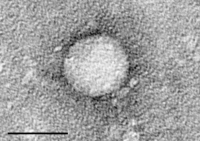
Photo from wikipedia
Approximately one-third of patients infected with chronic HCV have cirrhosis, and this is likely to increase in the near future. The risk of complications, mainly the development of hepatocellular carcinoma,… Click to show full abstract
Approximately one-third of patients infected with chronic HCV have cirrhosis, and this is likely to increase in the near future. The risk of complications, mainly the development of hepatocellular carcinoma, depends on the presence of cirrhosis, and a significant increase in the incidence of cirrhosis-related events, including mortality, is likely in the following years. All-oral therapy with direct-acting antivirals (DAAs) offers a safe and short treatment, with cure rates over 90% in compensated cirrhosis. Cirrhotic patients should be given high priority for treatment because viral clearance has a significant impact on the natural history of HCV infection, halting the progression of the disease and inducing the regression of fibrosis, as well as reducing the need for liver transplantation and improving survival. The benefit of DAAs is great in patients with decompensated cirrhosis, up until recently a population for whom no alternative therapy was available. The efficacy of all-oral therapy has been reported to improve liver function in about 50% of Child–Pugh class C patients. The regression of cirrhosis observed in more than half of patients achieving viral eradication on prior interferon-based regimens still has to be demonstrated in patients treated with DAAs, although there is reason to believe that this will happen. Advanced cirrhosis will eventually become the last boundary of antiviral therapy that will soon be conquered with new drugs currently pending approval.
Journal Title: Antiviral Therapy
Year Published: 2017
Link to full text (if available)
Share on Social Media: Sign Up to like & get
recommendations!